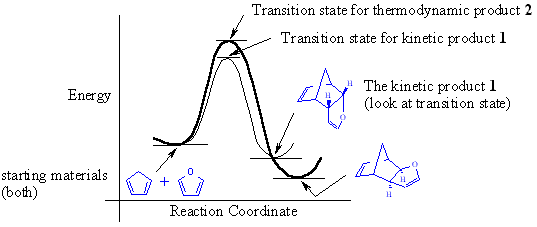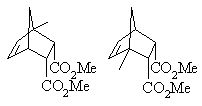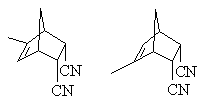| Qu1: |
(a) The diene is cyclopentadiene and the dieonphile
is furan.The sole formation of 1 (and not 2) at 20oC
is an example of a reaction under kinetic control. |
|
(b) Product 1 is endo and product
2 is exo. Look at the relative position of the furan unit
with respect to the bridghead CH2 unit. |
|
(c) The sole formation of 1 (and not 2)
at 20oC is an example of a reaction under kinetic control. |
|
(d) The mixture of 1 and 2 formed
at 80oC from cyclopentadiene and furan is an example of a reaction
under thermodynamic control since heating 1 also provides the same
equilibrium mixture. |
|
(e) No since this would require an inversion of sp3
hybridised C atoms.. |
|
(f) We can not convert the remaining 10% of 1 into
2 since the 9:1 ratio represents the equilibrium mixture. |
|
(g) The Hammond Postulate indicates that the transition
state will be most like the species it is closest to in energy, so if the
reaction is exothermic it should be the starting materials, cyclopentadiene
and furan. |
|
(h)  |
|
|
| Qu 2: |
(a) |
|
 In this Diels-Alder reaction, since the concerted additon
reaction is stereospecific, the cis dienophile gives cis products, but since
both faces can be attacked enantiomeric products are produced. Compare
the position of the methyl group from the diene with the following example.
In this Diels-Alder reaction, since the concerted additon
reaction is stereospecific, the cis dienophile gives cis products, but since
both faces can be attacked enantiomeric products are produced. Compare
the position of the methyl group from the diene with the following example. |
|
(b) |
|
 In this Diels-Alder reaction, since the concerted additon
reaction is stereospecific, the cis dienophile gives cis products, but since
both faces can be attacked enantiomeric products are produced. Note
how the position of the methyl group has changed in this example.
In this Diels-Alder reaction, since the concerted additon
reaction is stereospecific, the cis dienophile gives cis products, but since
both faces can be attacked enantiomeric products are produced. Note
how the position of the methyl group has changed in this example. |
|
|
|
|
| Qu 3: |

|
|
First looking for the diene of the Diels-Alder reaction.
If you draw the curly arrows for the retro-Diels-Alder reaction, by starting
from the C=C in the product then the furan diene is readily revealed and
the dienophile must be MeO2CCH=CHCO2Me. Given that
the product has the two ester groups trans-, the dienophile must
have also been trans. |
|
|
| Qu 4: |

|
|
|
| Qu 5: |
(a) |
|
In the Diels-Alder reaction the dienophile is usually
the electrophile, so electron withdrawing groups will enhance their reactivity.
Since the -C=O group is electron withdrawing by resonance, then we get giving
iii > ii > i. |
|
(b) |
|
This Diels-Alder reaction requires that the diene be
able to adopt an s-cis conformation. Since cyclopentadiene is locked in
this conformation, butadiene can achieve it by rotation about the C2-C3
bond. BUT, (i) is locked in s-trans and so it is therefore un-reactive.
Thus, ii > iii > i. |
|
(c) |
|
We are looking at the diene component of a Diels-Alder
reaction. Benzene does not react like a diene very easily as is it would
result in the loss of aromaticity. Between the 2 substituted butadienes,
the cis methyl groups in iii sterically destabilise the reactive
s-cis conformation making it less favorable, so ii > iii. Overall,
ii > iii > i. |
| |
|




